Pricing Guides & Dictionary of Makers Marks for Antiques & Collectibles

ANTIQUE AND COLLECTIBLE MECHANICAL BANKS:
A Brief History and Guide
Join the most updated and complete collectibles research online - Learn more...
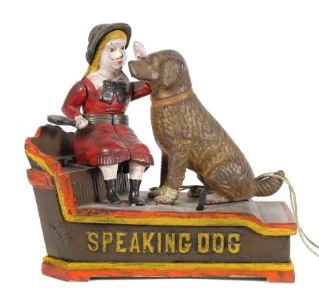 Antique mechanical banks have fascinated collectors and enthusiasts for generations. These mechanical banks were first introduced in the mid-19th century and quickly became popular among children and adults alike. Today, antique and collectible mechanical banks are highly sought-after by collectors and can fetch high prices at auctions and in antique shops. In this article, we will take a look at the history of mechanical banks and provide a guide for those interested in collecting them.
Antique mechanical banks have fascinated collectors and enthusiasts for generations. These mechanical banks were first introduced in the mid-19th century and quickly became popular among children and adults alike. Today, antique and collectible mechanical banks are highly sought-after by collectors and can fetch high prices at auctions and in antique shops. In this article, we will take a look at the history of mechanical banks and provide a guide for those interested in collecting them.
The History of Mechanical Banks
The first mechanical banks were invented in the mid-19th century and quickly became popular among children and adults. These banks were designed to make saving money fun and engaging, and they were often shaped like animals or buildings. To use a mechanical bank, a user would place a coin in a slot, and the bank would perform a mechanical action, such as a dog jumping through a hoop or a clown juggling balls. The action of the bank was powered by a spring or lever, and it provided an entertaining way for people to save money.
Mechanical banks were manufactured by a variety of companies, including J & E Stevens, Kyser & Rex, and Shepard Hardware Company. These companies produced a wide range of banks, including animal banks, building banks, and novelty banks. Some of the most popular banks included the "Speaking Dog" bank, which featured a dog barking and wagging its tail when a coin was inserted, and the "William Tell" bank, which featured William Tell shooting an apple off of his son's head.
Mechanical banks continued to be popular throughout the late 19th and early 20th centuries, and they were produced in large quantities. However, the Great Depression of the 1930s led to a decline in the production of mechanical banks, and they eventually fell out of favor as more modern forms of banking became popular.
Collecting Mechanical Banks
If you are interested in collecting mechanical banks, there are a few things to keep in mind. First, it is important to understand that mechanical banks can vary widely in price depending on their rarity and condition. Some banks can sell for tens of thousands of dollars, while others may only be worth a few hundred dollars. It is important to do your research and learn as much as you can about the banks you are interested in before making a purchase.
When collecting mechanical banks, it is also important to pay attention to the condition of the bank. Banks that are in good condition with all of their original parts and paint are typically worth more than banks that have been restored or have missing parts. It is also important to be wary of reproductions and fakes, as these can be difficult to distinguish from the real thing. Working with reputable dealers and collectors can help ensure that you are purchasing authentic banks.
Here are a few tips for collecting mechanical banks:
- Start small - Begin by collecting banks that are in your price range and build your collection over time.
- Do your research - Learn as much as you can about the banks you are interested in, including their history, rarity, and value.
- Pay attention to condition - Banks in good condition with all of their original parts and paint are typically worth more than banks that have been restored or have missing parts.
- Work with reputable dealers and collectors - This can help ensure that you are purchasing authentic banks and avoid reproductions and fakes.
- Join a collectors' club - Joining a club can help you connect with other collectors and learn more about the history and value of mechanical banks.
When building your collection, it can be helpful to focus on a specific type of bank, such as animal banks or building banks. This can help you develop a more focused and cohesive collection. It is also important to keep in mind that mechanical banks can be fragile, so it is important to handle them with care and store them properly to avoid damage.
Conclusion
Antique and collectible mechanical banks offer a fascinating glimpse into the history of banking and popular culture. These banks were designed to make saving money fun and engaging, and they continue to captivate collectors and enthusiasts today. Whether you are interested in collecting mechanical banks for their historical value, their aesthetic appeal, or their investment potential, it is important to do your research and work with reputable dealers and collectors to ensure that you are building a valuable and authentic collection.
Unlock the true value of your collection with our comprehensive research guides from identifying makers' marks to appraising all kinds of antiques and collectibles, including items featured in this article.
Our up-to-date information will give you an accurate understanding of your items' worth. Don't miss out on this valuable resource - visit our research tools today!
In addition to some examples shown below on this page, you can also search our price guide for your own treasures.
Examples of related items from our Price Guides
-
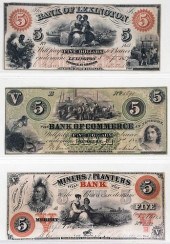 NORTH CAROLINA OBSOLETE BANK NOTES, OTHE
[more like this]
NORTH CAROLINA OBSOLETE BANK NOTES, OTHE
[more like this]
-
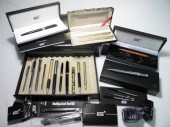 Collection of assorted pens. Includes ba
[more like this]
Collection of assorted pens. Includes ba
[more like this]
-
 JEWELRY. (4) MEN'S ELGIN MECHANICAL WATC
[more like this]
JEWELRY. (4) MEN'S ELGIN MECHANICAL WATC
[more like this]
-
 LOT OF CHINESE PAPER CURRENCY, 1935 - 19
[more like this]
LOT OF CHINESE PAPER CURRENCY, 1935 - 19
[more like this]
-
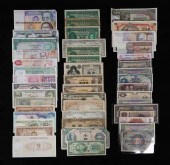 WORLD BANK NOTESNicaragua Cinco Centavos
[more like this]
WORLD BANK NOTESNicaragua Cinco Centavos
[more like this]
-
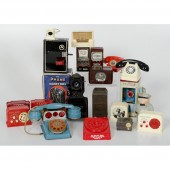 Large Lot of Radio Telephone and Televis
[more like this]
Large Lot of Radio Telephone and Televis
[more like this]
-
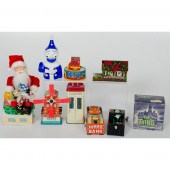 Lot of Boxed Mechanical Toy Banks Lot of
[more like this]
Lot of Boxed Mechanical Toy Banks Lot of
[more like this]
-
 GROUP OF SEVEN MECHANICAL TOYS. ''Quak Q
[more like this]
GROUP OF SEVEN MECHANICAL TOYS. ''Quak Q
[more like this]
-
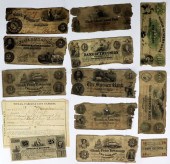 NOTAPHILY. ASSORTED OBSOLETE AMERICAN CU
[more like this]
NOTAPHILY. ASSORTED OBSOLETE AMERICAN CU
[more like this]
-
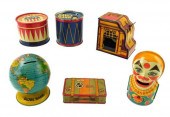 SIX TIN MECHANICAL AND STILL BANKS WITH
[more like this]
SIX TIN MECHANICAL AND STILL BANKS WITH
[more like this]
-
 JEWELRY. 3) VINTAGE MEN'S AUTOMATIC AND
[more like this]
JEWELRY. 3) VINTAGE MEN'S AUTOMATIC AND
[more like this]
-
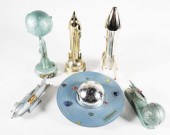 SIX VINTAGE SPACE THEME BANKSLot of 6 vi
[more like this]
SIX VINTAGE SPACE THEME BANKSLot of 6 vi
[more like this]
There are many more auction results available to our members...





